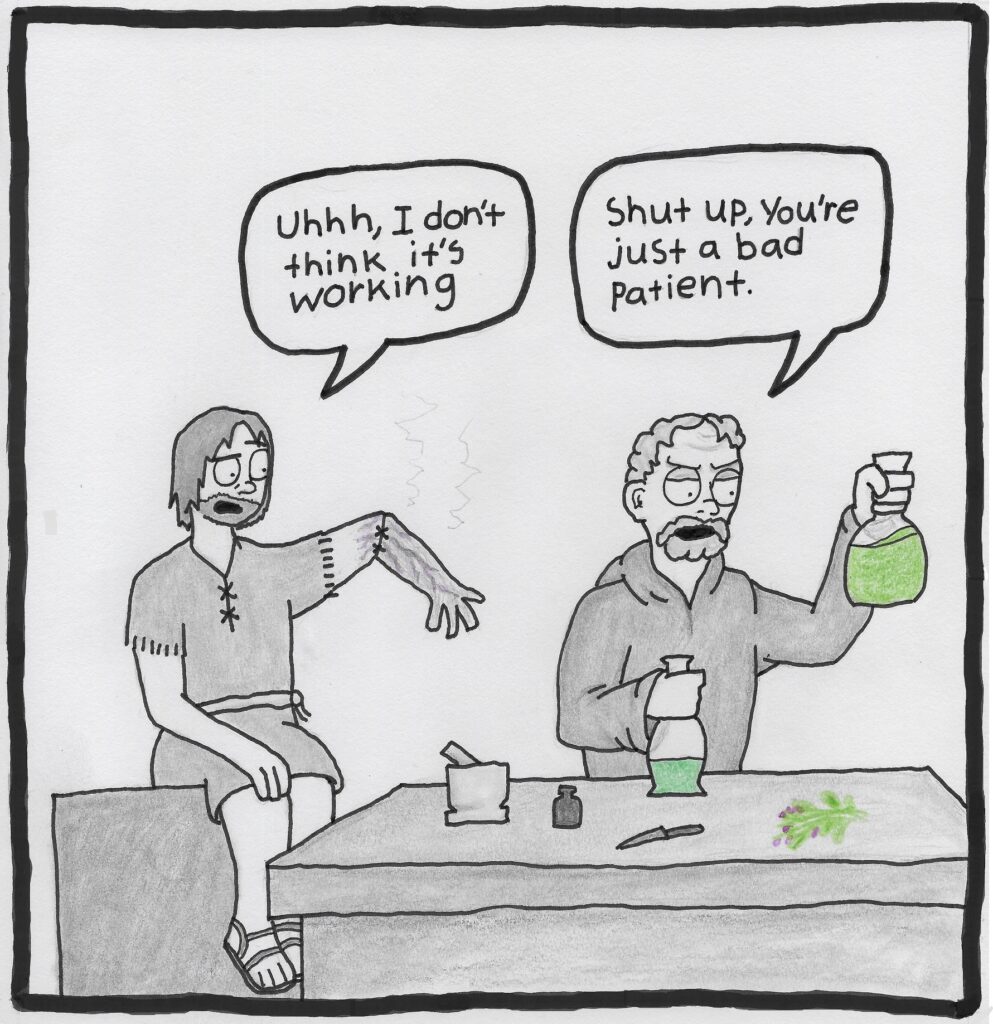
Description:
comfrey, is a large, coarse, tuberous-rooted perennial that is primarily grown today as an ornamental for its (I guess) cool looking foliage and pretty little spring flowers. It can grow up to 3 feet tall and has pretty big, pointed, hairy, ovate leave that are dark green and can grow to 8 inches long. Its little bell-shaped flowers grow in clusters near the tops of the branches and are usually a deep lavender color or straight up blue. These little bell-flower motherfuckers are a great source of pollen for bees so it’s got that going for it.
Way back in the day Pliny the Elder (23-79 AD) boiled a bunch of Comfrey down and was left with this sticky paste that he used to basically glue two pieces of meat together. This led to the assumption that if you can use Comfrey to turn two Rib-eye steaks into one big Rib-eye steak then clearly you can use comfrey to fix broken bones and reattach severed limbs. Obviously, you cannot; and this whole act of practicing the “meat gluing” theory went on for over a thousand years. So, for over a thousand years you had God knows how many people dying of sepsis all because some old-timey doctors were too stubborn to admit that once you get your arm chopped off, IT’S GONE and they can’t help you. Hell, even in “The English Physician Enlarged” (1653 AD) the herbalist Culpeper wrote that comfrey was “special good for ruptures and broken bones; yea it is said to be so powerful to consolidate and knit together, that if they be boiled with dissevered pieces of flesh in a pot, it will join together again.” So yeah, once again that’s humanity putting two and two together and coming up with nothing but a load of crap. I mean, like, there’s still some validity to the healing potential of comfrey, but it doesn’t come without risk; we’ll talk about that later so pay attention, bro.
There are over 35 different species of Comfrey but only two are traditionally used. These are Common Comfrey (S. officinale) and Russian Comfrey (S. x uplandicum). Now you’d think that Russian Comfrey would be Common Comfrey in Russia and Common Comfrey would be Uncommon Comfrey but you’d be wrong. Well, maybe you’d be right, I don’t know. I’ve only worked with Common Comfrey and Uncommon Comfrey is probably so Uncommon that you’ll probably never encomfer it.
Growing Habits:
Comfrey is native to most of Europe and has easily spread to east coast north America and some west coast states/provinces as well. It spreads hella easily by root cuttings and if you’re trying to get rid of it from your garden then good luck. You see, it has this super deep taproot which spreads itself out with lateral offshoots and if you try to pull it out of the ground and it leaves any of those lateral offshoots behind then BAM! More Comfrey. This plant spreads like a motherfucker and it does whatever it wants, but it generally wants to grow in damp grasslands along rivers and streams.
Therapeutic uses: muscle and joint pain, skin irritations, osteoarthritis, gout
Applied topically (typically in liniments and ointments) comfrey has been most commonly used for muscle/joint pain, skin irritations and to a lesser extent, gout. Oh yeah, and remember that meat gluing thing I was talking about earlier? Well, there actually is a LITTLE something to that, but I wouldn’t get your hopes up too high (seriously bro, if you lose a finger just GO TO THE FUCKING HOSPITAL). What I mean is that Comfrey contains a chemical called allantonin which encourages cell division and also helps tissues regenerate and heal. It also contains rosmarinic acid which is an anti-inflammatory and pain reliver. Now, despite the precautions that you’ll read below; this shit actually can be a pretty good wound herb in the short run. Now, I’m sure people back in the day were able to tell that Comfrey was good for healing up scrapes and bruises and shit like that just by experience. However, I know for a damn fact that my boys Pliny or Culpepper didn’t know what the hell allantonin was yet, so they don’t got any excuse for all those centuries of time wasted on meat-gluing.
Precautions:
Now, I’ve read some contradictory studies and tests done about the potential toxicity of this plant, so I can’t say for sure whether or not it will slowly kill you. Then again, I’m also a smoker so I can’t really talk shit but it would kinda be a dick move if I just said “have at it” without telling you wassup. Comfrey should not be taken internally. DO NOT EAT COMFREY. Seriously though, I’ve read books from the 70’s talking about putting this stuff in salads and shit. Well, you shouldn’t. Comfrey contains pyrrolizidine alkaloids which can have hepatoxic effects and could potentially be cancer causing. Because of these dangers, many herbal product manufacturers have developed methods of removing these alkaloids from their comfrey containing products and say so on their labels. So, look for that if you’re still hell bent of comfrey.